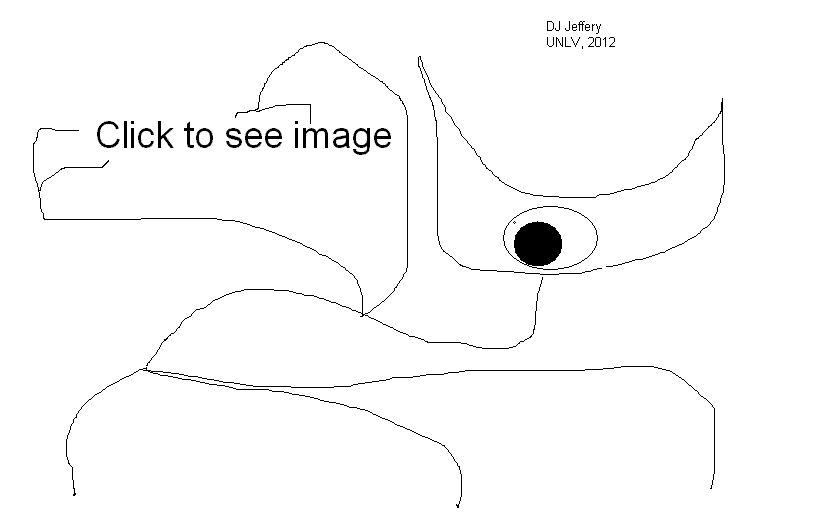
Caption: Click on the Alien image to see an illustration of the twins paradox, an illustration of the time dilation effect of special relativity.
Features:
- The astronaut
twin, who has gone on a round trip
at high velocities,
ages less than the
Earthbound twin.
- All clocks---mechanical
clocks,
atomic clocks,
biological clocks,
all clocks---show less
time has passed on
the spacecraft
than on Earth.
The astronaut twin notices NO time funniness in their reference frame (which is NOT a true inertial frame when there is acceleration). It is only by comparing their time flow to time flow in other reference frames that funniness is observed.
Time does flow at different rates in different reference frames. This is the time dilation effect.
- But, you say, shouldn't the situation be symmetrical.
From the
astronaut twin's
point of view, the Earthbound twin moved.
So shouldn't both twins have aged less? Isn't everything relative? This is a paradox.
- The resolution is that the situations are NOT symmetrical and all motions are
NOT relative.
The astronaut
twin
underwent significant accelerations relative
to local inertial frames
on their round trip---they had to speed up and turn around and slow down.
The Earthbound twin did NOT accelerate very much relative to inertial frames. They did accelerate a little since the Earth's rotation relative to the observable universe is an accelerated motion in the center-of-mass (CM) inertial frame of the Earth.
- If you work out case with the special relativity,
you get the right result:
the accelerated clocks
ran slow. Actually,
the effect is mnemonicked by saying
"Moving clocks run slow."
Actually, all moving clocks run slow. This point is explicated in some detail in file Relativity file: time_dilation_animation.html.
- The twins paradox
experiment has been done with
two "twin"
atomic clocks
since circa the 1970s.
The two atomic clocks are
synchronized on the ground.
Then one atomic clock
stays relatively at rest
on the ground and the other is
flown around the Earth
on a jet plane.
When they are brought together again less time has passed for the
atomic clock that
traveled.
In fact, in this experiment both the special relativity effect (called time dilation) and the general relativity effect (called gravitational time dilation) have to be accounted for. But the results agree with the predictions within uncertainty.
- In fact,
time dilation and
gravitational time dilation
both have to accounted for in order for the
Global Positioning System (GPS)
to work to high
accuracy/precision.
Thus, special relativity and general relativity do play roles in modern everyday life even if most people do NOT know it.
- An interesting point is that
the twins paradox
shows that
forward time travel
(i.e., time travel to the
future) can be done.
The astronaut
twin in the cartoon
did forward time travel.
Practically, it is impossible for any
macroscopic-scale object
to go more than a fraction of second
into future.
But, in principle, nothing prevents
forward time travel into
any future time in any
short period of travel time.
But special relativity forbids backward time travel (i.e., time travel to the past). Actually, forbidding time travel to the past is an extra minor of postulate deemed necessary since time travel to the past was deemed impossible since it is never seen and presents paradoxes that only scifi can solve. This postulate causes vacuum light speed to be the highest physical velocity (i.e., the highest velocity that information or any effect can propagate relative to a local inertial frame).
It's disappointing to scifi fans, but nature needs not backward time travel. So those time travel classics The Time Machine (1895), By His Bootrtaps (1941), etc. are just voyages of the imagination. See Wikipedia: List of time travel works of fiction.
Of course, you can replicate the past locally to some fidelity. We do this all the time when we remember.
- To undisappoint scifi
fans, though
Albert Einstein (1879--1955)
closed the door on
time travel to the
past with
special relativity, he
seems to have opened it again with
wormholes.
General relativity
predicts the possibility of
wormholes which are, among
other things, shortcuts between two points
in spacetime.
There are some theories that
wormholes allow
time travel to the
past or
future.
But they all sound very complex.
Note it is NOT known if
wormholes actually exist.
-
Credit/Permission: © unknown, before or circa
2012? /
No permission. Click on the shown image to see the described image.
Image link: Physics4me: Relativity?: Image link direct: Itself.
Placeholder image: alien_click_to_see_image.html.
Local file: local link: time_dilation_twin_paradox.html.
File: Relativity file: time_dilation_twin_paradox.html.